This post introduces Microsoft’s Fluid Framework and walks through a sample application to show how it can be integrated into projects.
Microsoft’s Fluid Framework is a new and exciting technology that has recently been open-sourced. Microsoft uses the Fluid Framework in many of its popular apps, including Office 365 and Teams.
The technology’s main use case is enabling collaboration and real-time updates across users. This is different than the classic SignalR technology in that it not only broadcasts real-time updates through WebSockets, but it also maintains those updates in that data through what is called a Distributed Data Structure (DDS).
Now that the Fluid Framework has been open-sourced, the technology can be utilized within client applications both within the Microsoft ecosystem and beyond. Example use cases for the Fluid Framework include:
- Shared projects (documents, presentations, etc.)
- Gaming
- Apps that need to mark presence (show a person is online)
- Brainstorming and ideation apps like Microsoft Visio or flow chart tools
- Team collaboration
Fluid’s main goal is to handle the piping and mechanics of real-time updates so that developers can focus on the experience rather than dealing with synchronizing messaging and data. The Fluid Framework provides helper methods and wrappers that enable your applications to have real-time updates.
This post will introduce the Fluid Framework and then walk through a sample application to show how it can be integrated into your projects. For a quick intro to what this technology looks like in action, check out the demo that was shown at Build 2019:
#developer #microsoft
